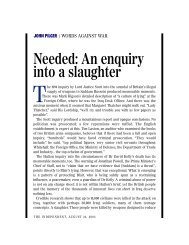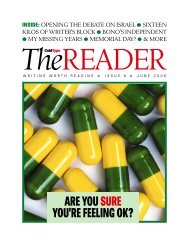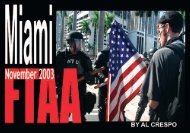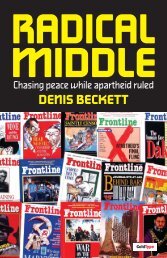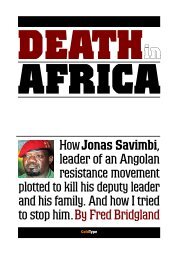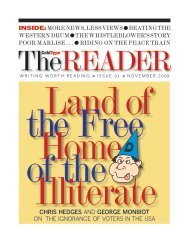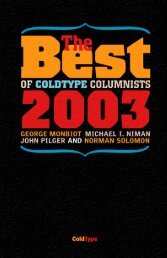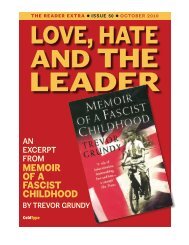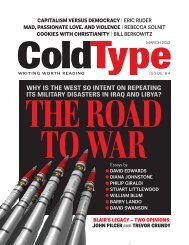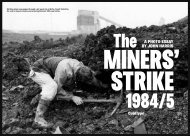UPDATED - ColdType
UPDATED - ColdType
UPDATED - ColdType
- TAGS
- updated
- coldtype
- coldtype.net
You also want an ePaper? Increase the reach of your titles
YUMPU automatically turns print PDFs into web optimized ePapers that Google loves.
EMBEDDED: WEAPONS OF MASS DECEPTION<br />
working on his doctorate. He says some soldiers<br />
encouraged the looting we saw:<br />
“I had gone to see some friends who live near<br />
a dilapidated area just past Haifa Avenue on the<br />
west bank of the Tigris. It was the 8th of April<br />
and the fighting was so intense that I was unable<br />
to return to the other side of the river. In the<br />
afternoon it became perfectly quiet and four<br />
American tanks took places on the edge of the<br />
slum area. The soldiers shot two Sudanese<br />
guards who stood at their posts outside a local<br />
administration building on the other side of<br />
Haifa Avenue. Then they blasted apart the doors<br />
to the building and from the tanks came eager<br />
calls in Arabic encouraging people to come close<br />
to them.<br />
“The entire morning, everyone who had tried<br />
to cross the road had been shot. But in the<br />
strange silence after all the shooting, people<br />
gradually became curious. After 45 minutes, the<br />
first Baghdad citizens dared to come out. Arab<br />
interpreters in the tanks told the people to go<br />
and take what they wanted in the building.<br />
“The word spread quickly and the building was<br />
ransacked. I was standing only 300 yards from<br />
there when the guards were murdered. Afterwards<br />
the tank crushed the entrance to the Justice<br />
Department, which was in a neighboring<br />
building, and the plundering continued there . . .<br />
“I stood in a large crowd and watched this<br />
together with them. They did not partake in the<br />
plundering but dared not to interfere. Many had<br />
tears of shame in their eyes. The next morning<br />
the plundering spread to the Modern Museum,<br />
which lies a quarter mile farther north. There<br />
were also two crowds there, one that plundered<br />
and one with watched with disgust.<br />
210<br />
Are you saying????<br />
“ARE you saying that it was U.S. troops who initiated<br />
the plundering?”<br />
“Absolutely. The lack of jubilant scenes meant<br />
that the American troops needed pictures of<br />
Iraqis who in different ways demonstrated<br />
hatred for Saddam’s regime.”<br />
“The people pulled down a large statue of Saddam?”<br />
“Did they? It was an American tank that did<br />
that, right beside the hotel where all the journalists<br />
stay. Until lunchtime on April 9, I did not see<br />
one destroyed Saddam portrait. If people had<br />
wanted to pull down statues they could have<br />
taken down some of the small ones without any<br />
help from American tanks. If it had been a political<br />
upheaval, the people would have pulled<br />
down statues first and then plundered.”<br />
Media post mortems<br />
THE media post mortems have begun with growing<br />
doubts being expressed over the effect on<br />
war reporting of the embedded journalists program.<br />
At the symposium I attended put on by the<br />
Edward R, Murrow School at Washington State<br />
University, mainstream journalists from AP, the<br />
Oregonian and the Wall Street Journal admitted<br />
that the whole story has yet to be told, and that<br />
the embeds, who most insisted were not censored<br />
or suppressed, could only see one part of<br />
the story. I keep trying to argue that most Americans<br />
get most of their news from TV, and that<br />
while many newspapers did offer more detailed<br />
reporting, there was more selling of the war than<br />
telling on the cable nets. I didn’t get much of an<br />
argument.



